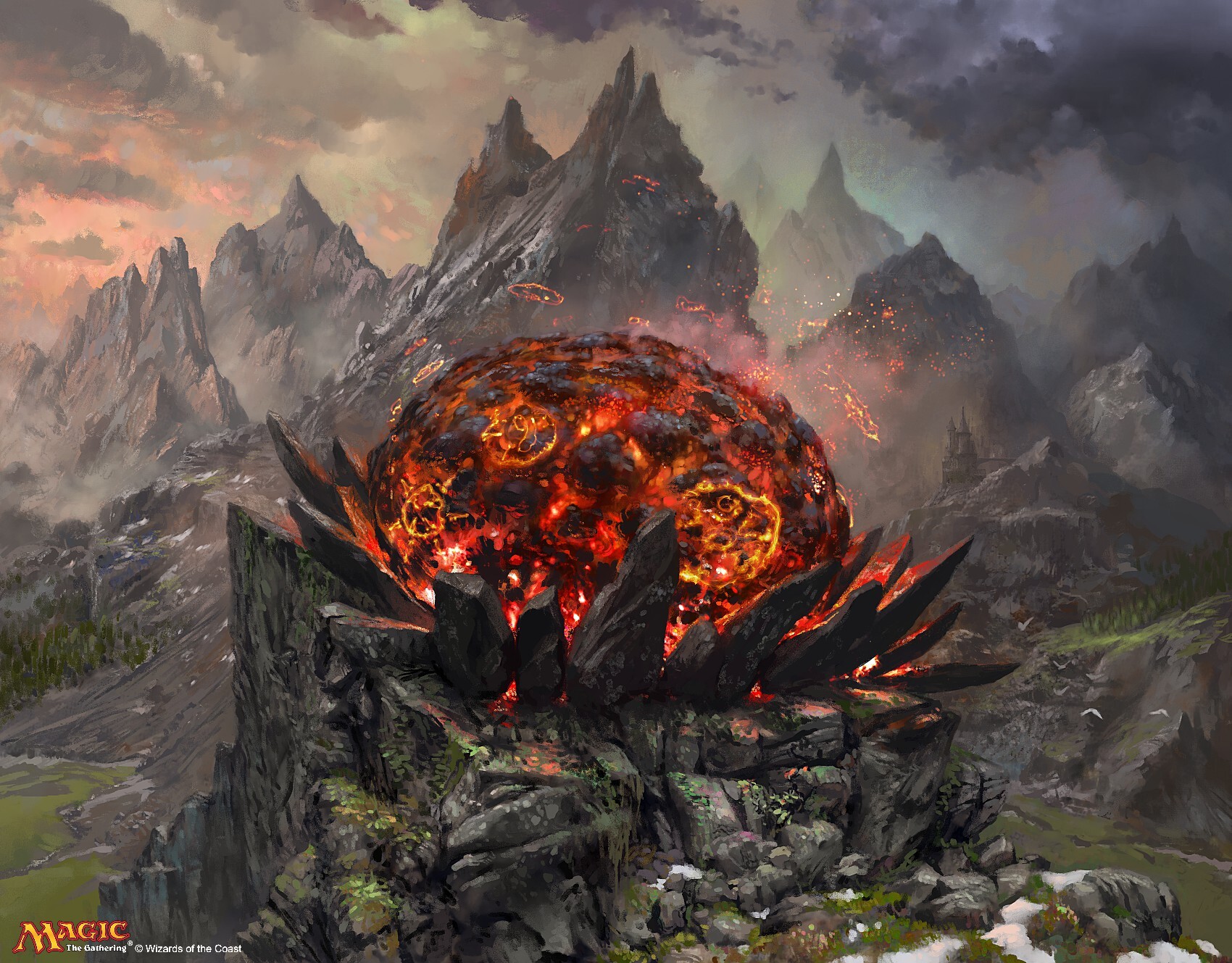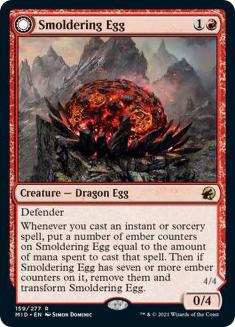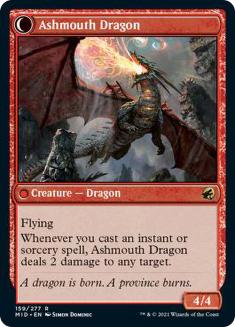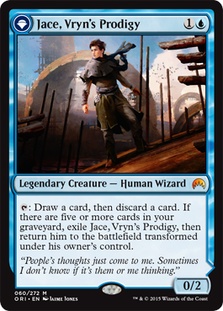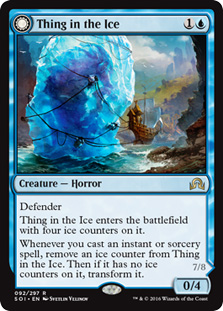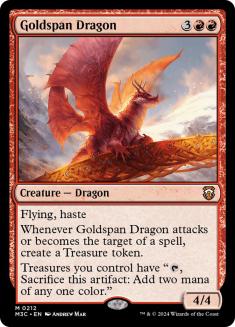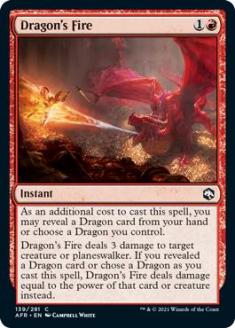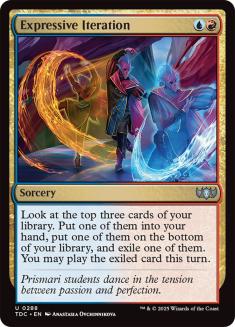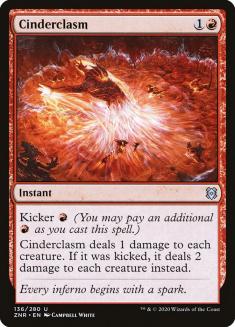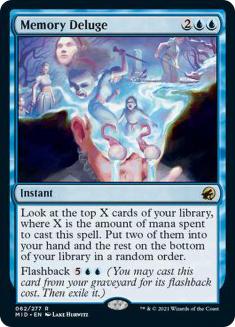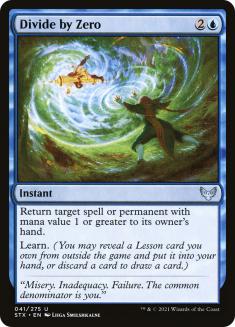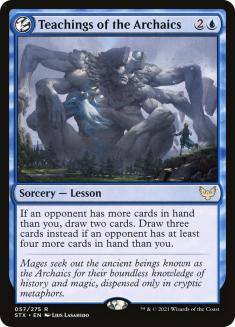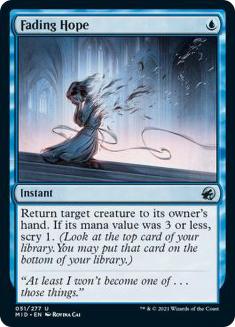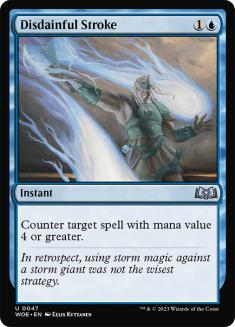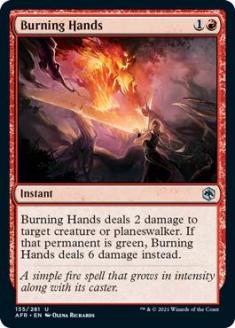Yuta Takahashi is the Magic: The Gathering world champion.
His weapon of choice was Izzet Dragons, something I’ve had some experience with over the last few weeks. My initial reads on the format were correct, as Izzet Dragons absolutely hammered all comers. As the format evolved with Alrund’s Epiphany pushing midrange out of the format, hyper-aggressive strats began to show up en masse. Without a natural predator, the low-to-the-ground aggro decks punished the Alrund’s Epiphany players that had morphed their deck to beat the mirror.
Yuta hit the nail on the head, moving back to Izzet Dragons and away from the combo-centric build of Alrund’s Epiphany featuring Galvanic Iteration. Goldspan Dragon is a great tempo play against aggro, establishing a battlefield presence while generating enough mana to cast cheap removal with every attack or removal spell cast against Goldspan Dragon. It could pressure planeswalkers, or just close the game quickly when you have an Alrund’s Epiphany at the ready. It’s no secret that Goldspan Dragon is a good Magic card. The Izzet Epiphany decks moved away from it completely, but why?
In today’s article, I’ll go over Yuta Takahashi’s winning Izzet Dragons list, focusing on the significant card choices that impacted his winning run the most, and discuss what cards were left out (and why). If you want to read my initial thoughts on Izzet Dragons, check out my article from two weeks ago.
What Went Right
When talking about a winning deck, it’s just as important to understand the “why” in addition to the “what.” Yuta’s build of Izzet Dragons was spot on, producing an unblemished record in the Constructed portion of the event. Against the best in the world, it’s impossible to ask for better than “undefeated.” But why, or how, did Yuta go undefeated with Izzet Dragons? After my initial thoughts on the format, the metagame shifted drastically. It seemed like few people could play stock Izzet Dragons and win a tournament. Were the aggro decks too good? Were you an underdog to Izzet Epiphany versions?
The true strength of Izzet Dragons, and decks like it, comes from its versatile nature in piloting and deckbuilding. Like Jeskai Black, one of my all-time favorite archetypes from years ago, you can bounce between reactive and proactive elements to fend off whatever the rest of the format is throwing at you. If Mono-White Aggro❄ is beating you down, maybe try a few more sweepers or cheap removal spells. If midrange is running rampant, a few copies of Disdainful Stroke are just what the doctor ordered.
Let’s go piece by piece and see exactly what Yuta did right.
I’ve been a huge proponent of Smoldering Egg in the maindeck of virtually every version of Izzet. The first time I played with it, I realized just how easy it was to transform so long as you fill your deck with a few specific cards. Ashmouth Dragon is also an absolute beating against just about every opponent. The only reason to not play Smoldering Egg in your deck is to dodge spot removal, a type of interaction that has significantly been on the decline.
Smoldering Egg is solid against aggro, but weak against specifically Blizzard Brawl. It’s one of the better threats against other Izzet decks because it has four toughness to dodge most burn, and comes down early enough to be a threat without tapping you out in later turns. One of the easiest ways to lose the game in an Izzet mirror is to tap out around Turn 6 or 7 and fail to resolve your spell. That ultimately opens you up to big plays from your opponent, so what actually ends up happening is both players just sit there and stare at each other until one person blinks.
Smoldering Egg allows you to break that paradigm, establishing a foothold on the battlefield before your opponent starts casting their relevant game-enders. Does Smoldering Egg look weak against Divide by Zero or Fading Hope? Sometimes, but those cards aren’t exactly answers. You can still recast Smoldering Egg, build it back up again, and still hold up counterspells in the mid-game.
Smoldering Egg is the key to what makes this deck better than other builds of Izzet. It’s just a creature, but it’s cheap and helps put your other spells through their paces. It’s the beginning of what’s good about this build, but the rest of the configuration is centered around this focal point. Without Smoldering Egg, none of this works, but the opposite is also true. Smoldering Egg makes a bunch of cards better, but Smoldering Egg also gets a lot worse if you’re not playing Goldspan Dragon. If you only have four creatures in your deck, your opponent’s removal will overload your threat base. Playing eight to twelve threats in a deck like this is often correct because it means your second (or sometimes third) threat is more likely to stick around.
Smoldering Egg also benefits from only costing two mana, which means it’s functional (and good) against aggro decks. One downside to control strategies is that your win conditions are often cumbersome and require a lot of mana. When aggro decks pressure you early, your end-game cards are usually weak or sometimes useless. Smoldering Egg can play defense and does it quite well. It’s rare that control decks get access to a card like this. The last two I remember were Jace, Vryn’s Prodigy and Thing in the Ice, both excellent creatures with extremely different uses.
Increasing your threat density is important for making sure one of them sticks around to finish the job. Goldspan Dragon is the perfect complement to Smoldering Egg because it’s such a good standalone card. When you have a build-around threat, you can’t often afford for your other threats to also require a lot of work. Goldspan Dragon can come down in the midgame, pop your opponent for four damage or kill their planeswalker, and then boost you by two mana so you can interact on your second main phase. The ability to cast Goldspan Dragon and a removal spell in the same turn is bonkers against the aggro decks in the format.
Goldspan Dragon is great against opposing removal, generating some extra mana for your trouble. Most opponents weren’t expecting it because Izzet Epiphany with Galvanic Iteration didn’t play any creatures maindeck. That means they’re likely to tap out on the fourth turn or so for card advantage stuff, often opening a window for Goldspan Dragon to clean up easily.
Goldspan Dragon also gives you a reason to play what is my pick for best removal spell in the format.
Two mana to kill a four-toughness creature is nothing new, but it’s rare in the current Standard format. At instant speed, you also get to hold up a counterspell in the middle turns to protect yourself from off-kilter permanents like Ranger Class or other oddballs. Dragon’s Fire is usually going to deal three damage for two mana, but the times you get to kill Old-Growth Troll will make all the difference.
I’ve tried Cathartic Pyre and just about every other mediocre removal spell in Standard, but three damage just doesn’t get the job done sometimes. Yuta went even further and decided that a few copies of Thundering Rebuke were also necessary, giving him more ways to kill those large creatures from Mono-Green Aggro❄. This is significant because it adds more potential turns where you can cast Goldspan Dragon and a removal spell after combat.
A lot of the Izzet Epiphany builds were shying away from Expressive Iteration because they didn’t have many proactive spells to play in the early turns. Smoldering Egg is exactly the type of proactive card you want to play with Expressive Iteration because it gives you some benefit for using all your mana on every turn possible. Expressive Iteration is a bit weaker when paired with a lot of counterspells, but Izzet Dragons isn’t all that interested in countering your stuff. This build is geared toward killing creatures, which is where Expressive Iteration shines.
In older formats, Expressive Iteration is one of the best card advantage spells around. It’s easy to turn it into a two-for-one, and is your best draw once the game has gone late. It helps you hit land drops, find interaction, and dig for threats when the game is at a standstill. The only downside of Expressive Iteration is that it can’t really be cast on the second turn for full value, but all that means is you really need to play something on the second turn. Luckily, this build of Izzet Dragons does that easily.
When the format is aggressive, playing cheap removal and emptying your hand is relatively easy. Cards like Expressive Iteration shine when you’re trading one-for-one against threats that often generate a little bit of extra advantage. Yuta expected a lot of aggro and built his deck accordingly.
I wasn’t high on Cinderclasm in my initial builds, but I’ve since come around thanks to the overwhelming presence of Mono-White Aggro❄. That deck is a nightmare, but a single Cinderclasm can create plenty of time for you to gain a foothold. The front half, unkicked, can usually kill two creatures. A kicked version will usually wipe their entire battlefield. Of all the sideboard changes, this one is probably my favorite. It’s also made better by your opponent overloading the battlefield with threats to attack through Smoldering Egg.
Lastly, I wanted to talk about Memory Deluge and its role in this archetype. I’ve been hesitant to play four copies because of how easily it gets stuck in your hand against aggro, but it’s far too good with Smoldering Egg to play fewer than four copies. My initial take was that you needed more Dragons for Dragon’s Fire, and I opted to play Moonveil Regent in some number in that slot.
I was wrong.
Memory Deluge was also not a four-of in many of the Galvanic Iteration builds of Izzet Epiphany because it does not work when you copy it. Because we are Dragon-focused and not all-in on Alrund’s Epiphany, we don’t have to play trash like Behold the Multiverse when we have such a potent card draw spell.
Memory Deluge might be better than Fact or Fiction. I’ve seen it in a few Modern decks already, and I can’t imagine playing a blue deck in Standard without some number. It’s certainly an excellent card, but having tension with Galvanic Iteration means you need to make some sacrifices. Yuta did not need to make sacrifices because he decided to play Dragons instead of Fork.
What Got Cut
Divide by Zero was an all-star against midrange decks. For three mana, you could stall out their four- or bigger-drop and gain a relevant card for your troubles. Bouncing a permanent that was giving you grief is still fine, but isn’t nearly as useful when everyone is playing aggro. Bouncing a one- or two-mana creature with Divide by Zero is heinous, as it isn’t actually answering the problem and is trading down on mana used.
Divide by Zero is one of my favorite cards in Standard right now, but it’s only as good as the format allows. Trimming a few to make room for removal like Thundering Rebuke makes sense in a world full of Old-Growth Troll. If we’re trying to lower our curve, trimming on three-drops makes a lot of sense. If midrange decks come back in a big way, or some banning shakes things up, Divide by Zero will gain some traction, but for now I’m down to trim a few.
With the trimming of Divide by Zero, cutting one Lesson is fine. Teachings of the Archaics is the worst of the bunch. Cutting it makes a lot of sense. It’s also worse when you’re lowering the count of bounce spells, as your opponent won’t have a grip full of cards as often.
Much like Divide by Zero, Fading Hope doesn’t actually answer the problem at hand. It just stalls the opponent long enough to start casting Alrund’s Epiphany. If I’m being honest, Alrund’s Epiphany isn’t exactly the nuts in this deck. You don’t have Galvanic Iteration to combo with it, and if your opponent kills your creature, then you might just end up with some free Bird tokens. When that happens, you realize how weak a Time Warp effect can be without any sort of combo or battlefield presence.
Fading Hope and Divide by Zero are great at stalling the game until you can start resolving Alrund’s Epiphany, but since our build isn’t focused on that necessarily, those cards get weaker. Because those cards are weaker, Alrund’s Epiphany is also weaker. We’re able to answer things permanently, so it’s not necessary to bounce everything when we can instead kill everything.
In my previous article on Izzet Dragons, I spoke of using those bounce spells as temporary answers to threats that you couldn’t handle. You didn’t need to actually kill the creatures because you would usually win the game while your opponent had four or five cards stranded in hand. That’s the nature of Alrund’s Epiphany, and closing the game via a Time Warp effect. As we reduce the number of bounce spells, or the number of Alrund’s Epiphany, it makes sense that the other side of that coin would/should also reduce in number.
Situational counterspells are often good, but the format has to be ripe. If everyone is jamming a ton of weird permanents, Negate can be one of your better interactive tools. Stopping something on the stack is so much easier than stopping it once it has entered the battlefield. The downside comes if your opponent is able to sneak a spell past your counter defenses. Once that thing has entered the battlefield, counterspells like Disdainful Stroke and Negate lose most of their value.
Disdainful Stroke is spectacular in a midrange-heavy format, but rather weak when everyone is playing aggro decks. It is a cheap piece of targeted interaction but it’s soft to spells that cost less than four mana. Disdainful Stroke is one of those counterspells that you cast alongside other spells later in the game. It allows you to use most of your mana on the fifth or sixth turn while providing a buffer from those expensive threats. In a world full of Mono-Green Aggro❄ and Mono-White Aggro❄, it’s unplayable. Negate suffers from similar problems against aggro decks, as they tend to focus on creatures, which Negate can’t affect.
I’ve seen a lot of builds, including some of my own, play maindeck Burning Hands. The card is solid, but somewhat underwhelming at times. My personal vendetta against the card comes from being on the business end of a Reckless Stormseeker, but that doesn’t happen as much these days. If Temur Midrange starts to gain in popularity, Burning Hands is okay but doesn’t interact well with their two biggest threats: Goldspan Dragon and Reckless Stormseeker.
I like Burning Hands as a sideboard card to overload on removal, but I’ve had a lot of mixed results with it in the maindeck slot. Moving it back to the sideboard in favor of Thundering Rebuke is great when we’re slimming down on counterspells and looking to play more Dragons for Dragon’s Fire.
Final Thoughts
Yuta Takahashi has always been known for playing blue decks that function like control but can turn on a dime. He’s known for his Faeries prowess, and this Izzet Dragons plays out much in the same way. We both gravitate toward control decks that have this closing speed. I, too, was a fan of Faeries back in the day, so saying I’m a fan of Yuta is an understatement. I followed his decklists closely, and cherish the one time I got to play against him in a side event at Worlds in 2008.
Watching Yuta win Magic World Championship XXVII, as a player I admire and with a deck I love, brought me so much joy. His passion for the game is unmatched, which is evident by his burst of emotion after winning his final match of Swiss.
His cry of passion, relief, happiness, and exhaustion all rolled into one almost broke me. I felt something inside myself stir for the first time in a long time. Professional tournament Magic has been a major part of my adult life, and these types of moments are only something I get to see or feel once in a blue moon. With the reduction of resources for Organized Play, I am fearful that the number of these moments will start to fade.
There are few people as deserving of the title of World Champion as Yuta Takahashi. His build was spotless, his play was immaculate, and his attitude was infectious. If we ever have a World Championship again, we’d be lucky if the next champion is a fraction as passionate about the game as Yuta.

